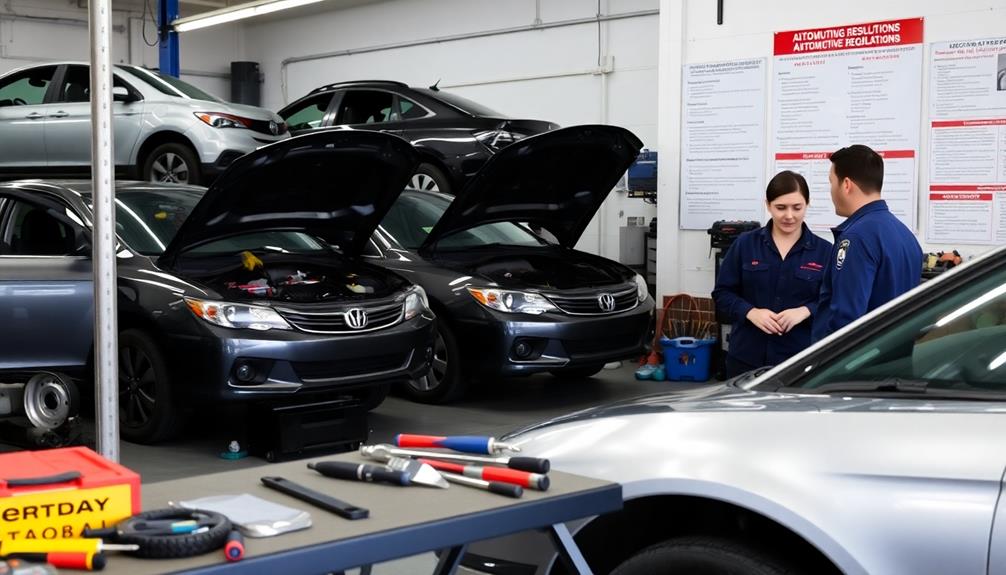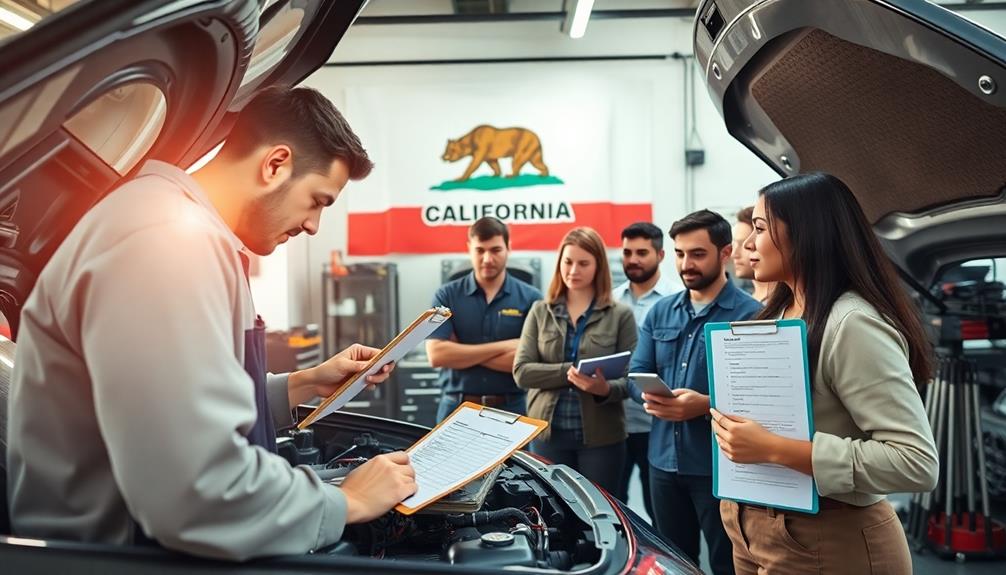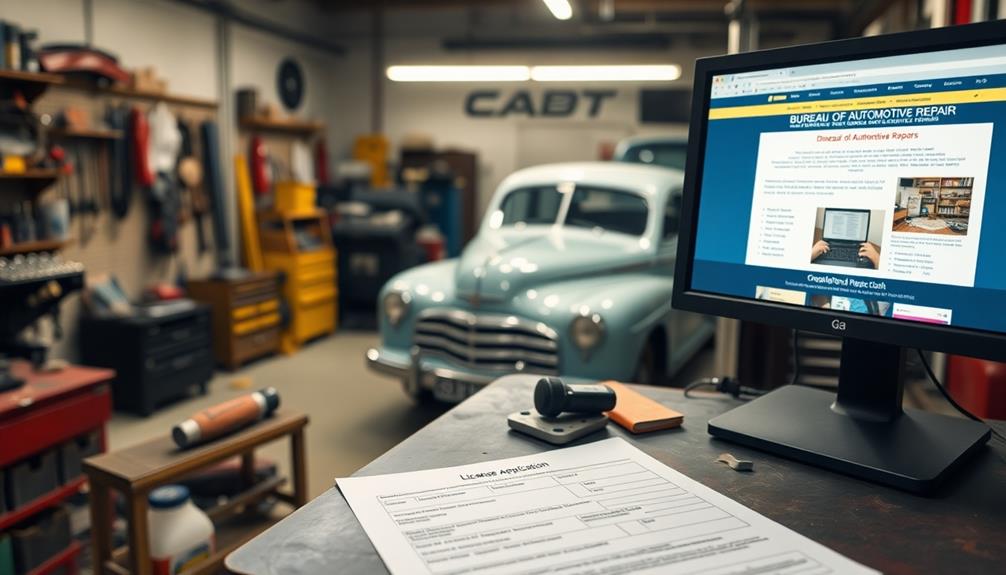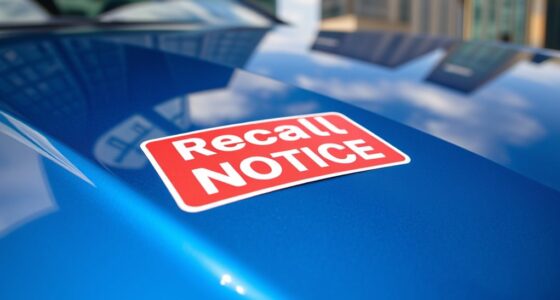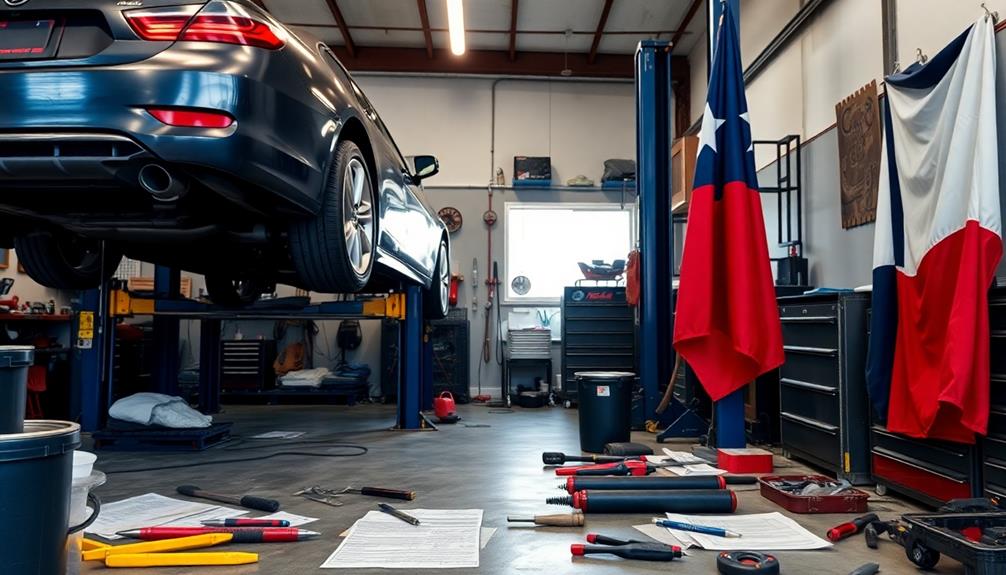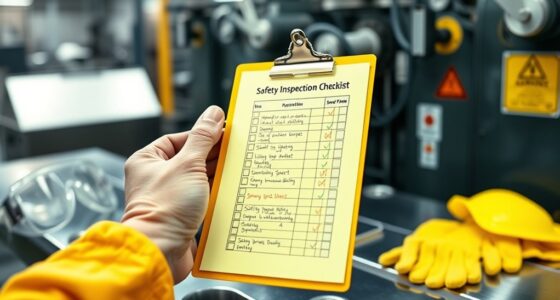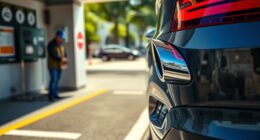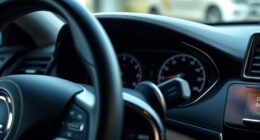The Bureau of Automotive Repair (BAR) protects you as a consumer by regulating and licensing automotive repair dealers in California. It guarantees these dealers adhere to safety and service standards, which helps prevent fraud and incompetence. BAR administers the Smog Check Program to improve air quality through vehicle emissions testing. If your vehicle fails, the Consumer Assistance Program (CAP) offers financial help for necessary repairs. Additionally, the STAR Program certifies high-quality inspection stations. With robust oversight, BAR helps you make informed decisions when choosing repair services. Stick around to explore how these programs can benefit you further.
Key Takeaways
- The Bureau of Automotive Repair (BAR) regulates and licenses automotive repair dealers to ensure consumer protection from fraud and incompetence.
- BAR administers the California Smog Check Program, conducting vehicle emissions inspections to improve air quality.
- It offers the Consumer Assistance Program (CAP) to provide financial support for repairs on vehicles that fail Smog Checks.
- The STAR Program certifies high-quality inspection stations, ensuring rigorous standards for emissions testing and overall vehicle safety.
- BAR oversees the Auto Body Inspection Program, providing complimentary inspections to verify the quality of collision repairs.
Overview of the Bureau of Automotive Repair
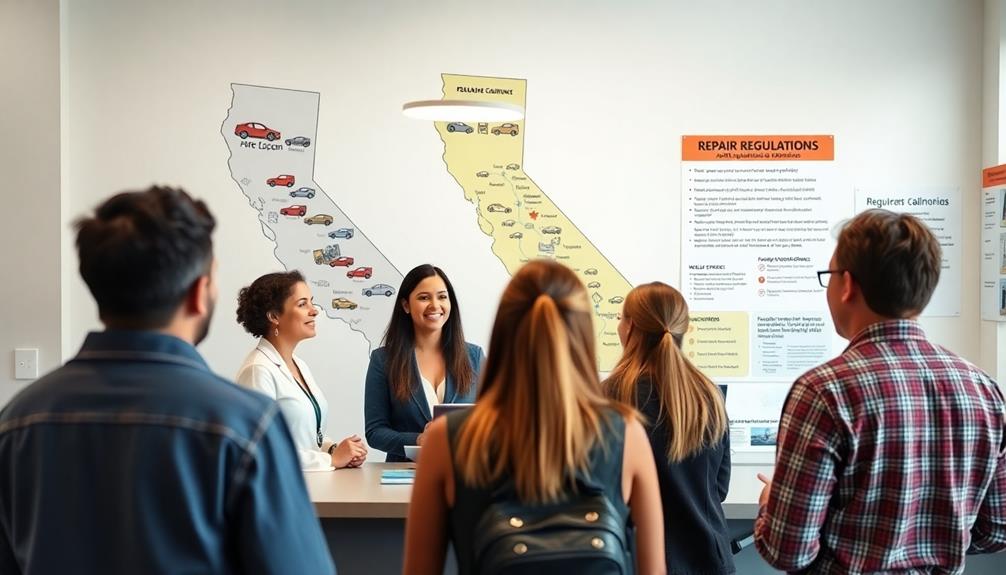
The Bureau of Automotive Repair (BAR) plays an essential role in safeguarding consumers in California's automotive industry. Established in 1972, it regulates and licenses automotive repair dealers, guaranteeing protection against fraud and incompetence. You can trust that the BAR works hard to maintain high industry standards.
One of its key initiatives is the California Smog Check Program, started in 1984, aimed at improving air quality by implementing mandatory vehicle emissions inspections. If your vehicle fails a Smog Check, the Bureau offers the Consumer Assistance Program (CAP) to help with repair costs.
Additionally, the STAR Program certifies inspection stations that meet high-quality standards, giving you peace of mind.
If you encounter issues with your Smog Check, the Bureau provides dispute resolution through the Referee Program. You can also rely on the Auto Body Inspection Program, which conducts free inspections to verify the quality of collision repairs.
Historical Background

Established in 1972, the Bureau of Automotive Repair (BAR) emerged as a response to rampant fraud and incompetence in California's automotive repair industry. This establishment followed the Automotive Repair Act of 1971, which aimed to protect consumers from dishonest practices. The Bureau received authority to license and regulate automotive repair dealers, as well as oversee lamp and brake inspection and repair services.
In 1984, BAR took on the significant role of administering the California Smog Check Program, focusing on vehicle emissions control to address environmental concerns. Through these initiatives, the Bureau has played a crucial role in enhancing public trust in automotive services.
To further support consumers, the Bureau developed several programs, including the Consumer Assistance Program (CAP) and the STAR Program. These programs are designed to provide assistance and guarantee that consumers receive fair treatment in automotive services.
Licensing and Regulation

When you take your car to a repair shop, it's essential to know that those businesses are licensed and regulated by the Bureau of Automotive Repair (BAR).
This oversight guarantees that automotive repair dealers meet strict criteria and that inspection services, like lamp and brake checks, adhere to safety standards.
Licensing Automotive Repair Dealers
Licensing automotive repair dealers is essential for ensuring that you receive quality service and protection as a consumer. Established in 1972 under the Automotive Repair Act of 1971, the California Bureau of Automotive Repair (BAR) serves as the licensing authority, ensuring that all automotive repair dealers meet established standards to operate legally.
When a repair shop is licensed by the BAR, it signifies that they comply with state regulations and consumer protection laws, giving you confidence in their services. The Bureau not only grants licenses but can also revoke them if dealers fail to adhere to these standards. This accountability helps to reduce fraud and incompetence in the automotive repair industry.
Additionally, the BAR regulates specific services like lamp and brake inspection and repair, ensuring these critical safety functions are performed by qualified professionals.
By maintaining rigorous licensing requirements, the California Bureau of Automotive Repair enhances consumer confidence, knowing that licensed dealers are held to industry standards and practices.
Regulating Inspection Services
The Bureau of Automotive Repair (BAR) plays an essential role in regulating inspection services in California, guaranteeing that automotive repair dealers not only meet licensing requirements but also adhere to strict safety standards.
As the licensing and regulating authority, BAR oversees important services related to lamp and brake inspection and repair, enhancing vehicle safety on the roads.
You'll find that BAR administers the California Smog Check Program, which monitors inspection stations conducting emissions testing. This oversight guarantees these stations comply with established guidelines, promoting accountability and protecting consumers from fraud or subpar services.
Through its regulatory framework, BAR helps maintain high standards across the automotive repair industry.
One standout initiative is the STAR Program, which certifies inspection stations that meet higher performance benchmarks. By choosing a STAR-certified station, you can be confident in receiving quality and reliable vehicle inspections.
The California Department of Consumer encourages consumers to utilize these regulated services, guaranteeing your vehicle is in good hands and safe to drive.
To summarize, BAR's commitment to regulating inspection services plays a fundamental part in safeguarding the public and enhancing overall vehicle safety.
Consumer Assistance Programs
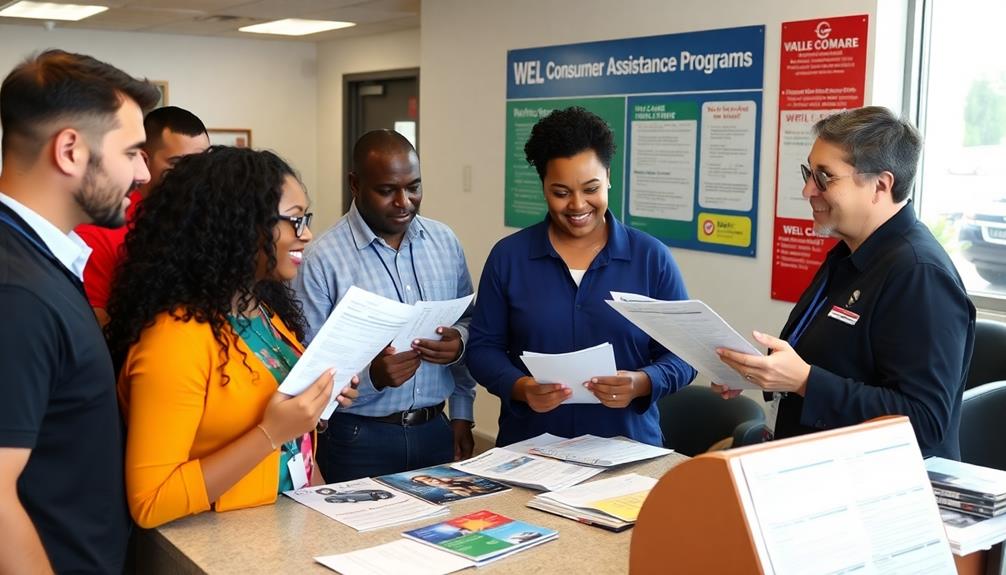
If your vehicle fails the Smog Check, you might be eligible for financial help through the Consumer Assistance Program.
This program offers repair assistance options and guarantees you receive quality inspection services at certified Smog Check stations.
Let's explore how these resources can support you in staying compliant with California's emissions standards.
Repair Assistance Options
While maneuvering through the challenges of vehicle repairs, you may find various consumer assistance programs designed to help ease the financial burden.
These programs aim to support consumers facing costly repairs, particularly when their vehicles fail Smog Check inspections. Here's a quick overview of some options available to you:
- Consumer Assistance Program (CAP): This program offers financial assistance to help cover the costs of necessary repairs for eligible vehicles that don't pass Smog Check inspections.
- STAR Program: By certifying automotive repair stations that meet stringent standards, this program guarantees you're getting quality service and compliance with environmental regulations when you need repairs.
- Auto Body Inspection Program: If you've had collision repairs, this program provides complimentary inspections to verify the quality of those repairs, assuring they meet safety and industry standards.
These repair assistance options enhance consumer protection and promote adherence to automotive regulations, helping you navigate the complexities of vehicle repairs while supporting environmental health initiatives in California.
Smog Check Support
Maneuvering through the Smog Check process can be intimidating, but you don't have to face it alone. The Bureau of Automotive Repair (BAR) is here to support you through its Consumer Assistance Program (CAP), which offers financial help for necessary repairs if your vehicle fails the Smog Check. This program guarantees your vehicle meets emission standards, contributing to cleaner air in California.
Additionally, BAR has created the STAR Program, certifying inspection stations that adhere to high-quality standards specifically for high-emitting vehicles. This initiative promotes better environmental outcomes while giving you peace of mind about where to take your vehicle for inspections.
If you encounter disputes regarding your Smog Check results, BAR's Referee Program is available to help resolve these issues. They also offer specialized inspections for atypical vehicles, guaranteeing transparency and fairness throughout the process.
Beyond assistance, the Bureau of Automotive Repair emphasizes educating vehicle owners on the importance of regular Smog Checks and how vehicle emissions affect air quality. Through these support programs, BAR plays a crucial role in reducing vehicle emissions and protecting your interests in automotive repairs.
Quality Inspection Services
How can you guarantee your vehicle receives the best inspection services while maneuvering through the complexities of automotive repairs?
The Bureau of Automotive Repair (BAR) offers several programs designed to enhance the quality of inspections in California automotive repair. By utilizing these services, you can ascertain your vehicle meets safety and environmental standards.
Here are three key programs to evaluate:
- STAR Program: This certifies automotive repair stations that adhere to higher inspection standards, particularly for high-emitting vehicles. Choosing a STAR-certified station means better compliance with environmental regulations.
- Referee Program: If you encounter disputes over Smog Check results, this impartial resource helps resolve issues, especially for atypical vehicles needing specialized assessments.
- Auto Body Inspection Program: This program provides complimentary inspections to verify the quality of collision repairs, ascertaining that they meet safety and industry standards.
STAR Program Details

In California, the STAR Program serves as a benchmark for automotive repair stations aiming to excel in emissions inspections and repairs. This program certifies repair stations that meet higher standards for inspecting high-emitting vehicles, guaranteeing compliance with the state's emissions regulations. To qualify, stations must demonstrate superior performance and customer service while passing rigorous testing and meeting specific equipment requirements.
Here's a quick overview of the STAR Program:
| Feature | Description | Benefit |
|---|---|---|
| Certification Process | Rigorous testing and quality standards | Guarantees high-quality service |
| Emissions Inspections | Focus on high-emitting vehicles | Contributes to cleaner air |
| Customer Service | Enhanced focus on consumer satisfaction | Builds trust and loyalty |
| Increased Business | STAR certification attracts more customers | Potential for higher revenue |
| Environmental Standards | Adherence to strict environmental guidelines | Promotes sustainability |
STAR-certified stations are recognized for their ability to perform Smog Check inspections and repairs on vehicles that fail initial tests. By participating in the STAR Program, you not only improve air quality but also enhance consumer confidence in your services.
Referee Program Functions
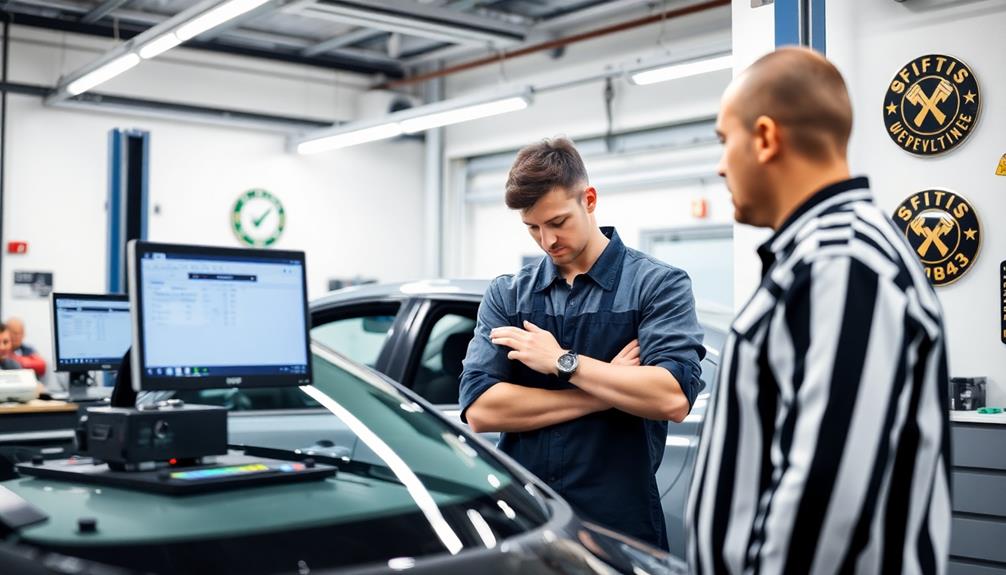
After ensuring your vehicle meets emissions standards through the STAR Program, you might still have questions or concerns about your Smog Check results. That's where the Bureau of Automotive Repair's Referee Program comes into play. This program provides essential support in resolving disputes and ensuring fairness in the inspection process.
Here are three key functions of the Referee Program:
- Dispute Resolution: If you disagree with your Smog Check results, the Referee Program acts as a neutral party to help you find a resolution.
- Inspection of Unusual Vehicles: The program conducts inspections on vehicles that don't fit standard Smog Check criteria, ensuring they're treated fairly and accurately assessed.
- Verification of Emissions Accuracy: It verifies the accuracy of emission control systems and checks if licensed stations correctly report Smog Check failures.
You can access the Referee Program through dedicated websites like asktheref.org for assistance.
Auto Body Inspection Services

If you're concerned about the quality of collision repairs on your vehicle, the Bureau of Automotive Repair's Auto Body Inspection Program offers a valuable resource. This program provides free inspections to confirm that repair work meets safety and quality standards, protecting you from substandard services. If you have doubts about the repairs performed after a collision, you can request an inspection, which will give you a transparent assessment of the repair quality.
Here's a quick overview of the Auto Body Inspection Program:
| Feature | Description | Benefits |
|---|---|---|
| Free Inspections | Inspections conducted at no cost | Saves money |
| Safety Standards | Verifies compliance with safety protocols | Enhances safety |
| Consumer Protection | Aims to hold repair shops accountable | Increases trust |
The Bureau of Automotive Repair is dedicated to promoting vehicle safety and consumer protection in the automotive repair industry. By utilizing this program, you can feel more confident in the repairs made to your vehicle, confirming it's safe for you and your passengers.
Impact on Consumer Confidence

The services provided by the Bureau of Automotive Repair greatly boost consumer confidence in the automotive repair industry. By regulating and licensing automotive repair dealers, the Bureau guarantees that they meet established standards of competence and integrity. This oversight helps you feel secure when choosing a repair shop for your vehicle.
Here are three key ways the Bureau enhances consumer confidence:
- Consumer Assistance Program: This initiative offers financial support for repairs needed after a failed Smog Check, easing your worries about emissions compliance.
- STAR Program: By certifying high-performing Smog Check stations, the Bureau assures you're receiving quality inspections, allowing you to trust the service your vehicle gets.
- Auto Body Inspection Program: With free inspections verifying the quality of collision repairs, you can be confident that your vehicle is restored to safe operating conditions.
Moreover, the Bureau's Referee Program facilitates dispute resolution, empowering you to address grievances with repair services. This fosters accountability and reinforces your trust in the automotive repair industry, guaranteeing you can make informed decisions for your vehicle's needs.
Environmental Initiatives and Smog Control

Driving towards a cleaner environment, the Bureau of Automotive Repair (BAR) plays an essential role in managing California's Smog Check Program, which has been in place since 1984. This program aims to reduce vehicle emissions, greatly improving air quality across the state.
Through the STAR Program, BAR certifies automotive repair stations that meet higher standards for inspecting high-emitting vehicles, guaranteeing compliance with vital environmental regulations.
If your vehicle fails a Smog Check, the Consumer Assistance Program (CAP) offers financial help for necessary repairs, promoting compliance among vehicle owners. This support encourages you to keep your vehicle in good condition, reducing its environmental impact.
Additionally, the Referee Program helps resolve disputes related to Smog Checks and conducts inspections on unusual vehicles. This guarantees that environmental standards are fairly enforced, giving you peace of mind during the process.
Frequently Asked Questions
What Is the Fine for the Bureau of Automotive Repair?
If you violate the Automotive Repair Act, fines can range from $1,000 to $5,000. Operating without a license might cost you up to $2,500, while serious Smog Check violations can hit up to $10,000.
What if I Get Work Done on My Car and It Doesn't Solve the Problem?
Did you know that over 70% of car owners experience unresolved issues after repairs? If your car's problem persists, document everything and reach out to the Bureau for guidance on your consumer rights and potential assistance.
How Do I File a Complaint Against an Auto Repair Shop in Texas?
To file a complaint against an auto repair shop in Texas, visit the TDLR website, complete the complaint form, and include details about the shop and your issue. Attach relevant documents for a stronger case. Once the form is submitted, the Texas Department of Licensing and Regulation (TDLR) will review the complaint and may contact you for further information. If the repair involves legal or ethical concerns, you may also choose to file a complaint with BAR (Bureau of Automotive Repair) if applicable. Be sure to follow up on the status of your complaint as the investigation progresses.
What Is the Meaning of Automotive Repair?
You might not realize it, but automotive repair means keeping your vehicle safe and efficient. It includes everything from fixing engines and brakes to ensuring electrical systems work, all essential for your driving experience.
Conclusion
In principle, the Bureau of Automotive Repair plays an essential role in keeping your wheels turning smoothly and safely. By regulating shops, offering support, and promoting environmental initiatives, it builds trust between consumers and the automotive industry. Just like a well-tuned engine, their efforts create harmony on the road. So, whether you're seeking help or just peace of mind, know that the Bureau's got your back, ensuring your ride stays reliable and eco-friendly.
